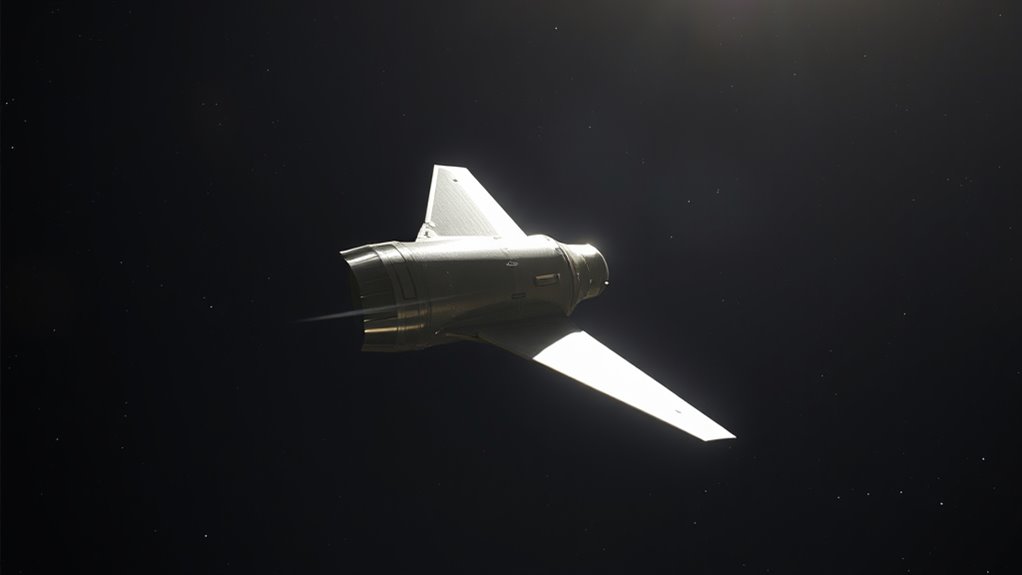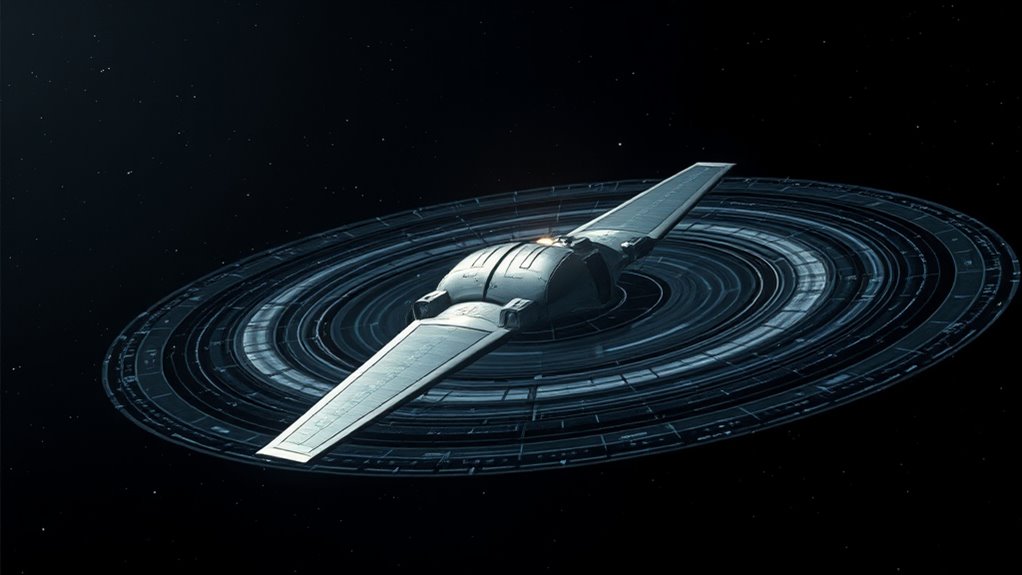NASA uses a technique called gravitational assists or gravity slingshots to save fuel on deep-space missions. By carefully timing and aiming spacecraft close to planets like Jupiter or Venus, they harness the planet’s gravity to boost speed and change direction. This method allows spacecraft to gain momentum naturally, reducing the need for extra fuel. If you explore further, you’ll discover how this clever trick is powered by the fascinating physics of orbits and gravity.
Key Takeaways
- NASA uses gravity assist maneuvers to boost spacecraft speed by leveraging planetary gravity fields.
- These maneuvers transfer orbital energy from planets to spacecraft, conserving fuel.
- Precise trajectory calculations and modeling optimize the timing and approach for maximum efficiency.
- The technique extends mission range and duration without additional fuel costs.
- Gravity assists enable missions to reach distant planets and objects more economically and effectively.

NASA employs a clever physics trick called gravity assists, which allows spacecraft to save fuel and extend their missions. This technique leverages the natural motion of planets and the principles of orbital mechanics to give spacecraft a boost in speed and trajectory without using additional fuel. When you understand how gravitational assists work, you’ll see how NASA cleverly uses the gravitational pull of planets like Jupiter, Saturn, or Venus to slingshot spacecraft into their desired paths. Instead of carrying all the energy needed for a long voyage, the spacecraft “hitches a ride” on a planet’s gravity, gaining momentum as it passes close by.
NASA uses gravity assists to boost spacecraft speed and extend missions by harnessing planetary gravity.
The core idea behind gravitational assists is rooted in orbital mechanics, the science that describes how objects move in space under the influence of gravity. When a spacecraft approaches a planet, it enters that planet’s gravitational sphere of influence. As it swings around the planet, it effectively exchanges energy with the planet, which results in a change in the spacecraft’s velocity and direction. Because planets are so massive compared to spacecraft, they experience only a tiny change in their own motion—so tiny that it’s practically negligible. The spacecraft, however, gains or loses speed depending on the encounter’s specifics. This process relies heavily on the precise calculations of orbital mechanics, which are essential for mission success.
You might think of it as a cosmic slingshot. The spacecraft approaches the planet with a certain velocity, but as it swings around, it gains additional speed by stealing a tiny bit of the planet’s orbital energy around the Sun. The process involves precise calculations of orbital mechanics to determine the *ideal* approach trajectory, ensuring the spacecraft maximizes its speed boost while minimizing fuel consumption. In addition, advanced computational modeling plays a crucial role in predicting and optimizing these complex trajectories. By carefully planning these flybys, NASA engineers can extend mission durations and reach distant planets or asteroids that would otherwise require enormous amounts of fuel. Additionally, the use of high-precision navigation ensures that these gravity assists are executed with maximum efficiency. Understanding the orbital dynamics involved helps scientists predict the outcomes of each maneuver with remarkable accuracy. Furthermore, advancements in computational modeling have significantly improved the precision of these gravity assist calculations over time.
Using gravitational assists isn’t just about saving fuel; it’s also about making missions feasible and more cost-effective. For example, the Voyager probes used multiple gravity assists to travel across the solar system, reaching the outer planets. Similarly, the Juno spacecraft to Jupiter and the upcoming missions to outer planets rely heavily on this technique. When you understand the physics behind these maneuvers, it becomes clear that NASA is taking advantage of natural celestial mechanics rather than fighting against them. This clever use of gravity assists exemplifies how understanding orbital mechanics can *disclose* the secrets of space travel, transforming complex physics into practical, fuel-efficient mission strategies.
Frequently Asked Questions
How Does Gravitational Slingshot Impact Spacecraft Trajectories?
Gravitational slingshots, or planetary flybys, impact your spacecraft’s trajectory by using orbital mechanics to accelerate or redirect it efficiently. When you pass close to a planet, its gravity pulls on your craft, increasing its speed and changing its path without using much fuel. This maneuver allows you to reach distant destinations faster, saving fuel and time, making deep-space missions more practical and cost-effective.
Can This Physics Trick Be Used for Interstellar Travel?
Imagine gravity assist as a cosmic dance partner guiding your spacecraft’s acceleration, propelling it toward distant stars. While this physics trick works wonders within our solar system, using it for interstellar travel is more complex. You’d need immense energy and precise maneuvers, making it less practical for reaching other star systems. Still, understanding gravity assist helps us dream bigger about future missions beyond our solar neighborhood.
What Are the Risks of Relying on Gravitational Assists?
You should know that relying on gravitational assists carries risks because planetary alignment isn’t always predictable. If you don’t plan your mission carefully, you might face delays or miss ideal windows for slingshot maneuvers. Unexpected changes in planetary positions or orbital conditions can disrupt your trajectory, increasing fuel consumption or jeopardizing the mission. Proper mission planning and monitoring planetary movements are essential to minimize these risks and guarantee success.
How Much Fuel Can NASA Save Using This Method?
Imagine the thrill of exploring new worlds while conserving fuel—that’s what NASA achieves with gravitational assists. By using planetary gravity, they boost spacecraft speed without extra fuel, greatly enhancing fuel efficiency. This clever technique profoundly expands mission planning options, allowing for longer journeys or more scientific instruments. You realize how such physics tricks open the universe’s secrets, making space exploration more sustainable and inspiring for future generations.
Are There Limitations to Applying This Physics Trick?
You might wonder if there are limits to using a solar sail or quantum tunneling. While solar sails can harness sunlight for propulsion, their effectiveness depends on sail size and distance from the Sun. Quantum tunneling, though promising for energy transfer, faces scale and stability challenges. These factors limit how much you can rely on these physics tricks, especially for long-term or deep-space missions where conditions vary markedly.
Conclusion
By harnessing the subtle pull of gravity, NASA transforms a potentially costly journey into an elegant dance with the cosmos. While rockets burn fuel to push forward, the gravity trick acts like a silent partner, guiding spacecraft effortlessly. It’s a clever reminder that in space, sometimes the simplest physics—like a gentle nudge—can make the biggest difference. So, next time you think of space travel, remember: it’s not just about power, but also about mastering the art of gentle influence.
Amina brings over a decade of journalism experience to her role as Editor-in-Chief. Under her leadership, Exquisite Post has flourished, maintaining the highest standards of integrity and excellence. Amina’s commitment to truth and her visionary approach guide the editorial team in producing impactful news stories that resonate with our audience.










